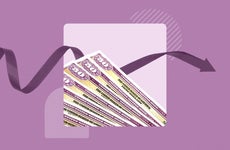Is it time to sell Series I bonds?

The Bankrate promise
At Bankrate we strive to help you make smarter financial decisions. While we adhere to strict , this post may contain references to products from our partners. Here's an explanation for .
Series I bonds have been a popular and attractive investment over the past few years, as inflation soared to multi-decade highs. The bonds adjust their interest rate to factor in inflation, helping investors offset rising prices, while also providing the safety of a government bond. But with inflation subsiding, is it time to start thinking about selling your Series I bonds?
Here are a few key things to consider as you’re thinking about investing in I bonds today.
Are Series I bonds an attractive investment now?
Because the interest rate on Series I bonds is based on inflation, the rate can fluctuate dramatically from time to time. The bonds are paying interest at 5.27 percent for a full six months for any bonds that are opened and registered before April 30, 2024. Of course, that’s substantially less than the 9.62 percent and 6.89 percent that investors could get last year.
So no one will argue that the rate is better now than it was in the recent past, but does it make sense to continue to hold your I bonds today or even pony up for more of them? Here are three key things to consider as you’re thinking about what to do about your I bonds.
1. You’re fighting the Federal Reserve
The Federal Reserve has been working furiously over the last two years to stomp out inflation, with some success. While inflation is below its highest level of mid-2022, it remains stubbornly high despite the central bank’s full-on assault. So the high returns of I bond investors depend on the Fed not succeeding, or in other words, they’re battling the Fed. There’s an old saying among investors: “Don’t fight the Fed.” The central bank has nearly limitless resources to do as it likes.
“Officials have been raising interest rates to starve the inflation flames of their main ingredients: Demand for goods and services,” says Sarah Foster, Bankrate’s U.S. economy reporter. “And they’ve made major progress. Inflation has slowed from a staggering 9.1 percent high in June 2022 to its recent 3.7 percent in August.”
If the Fed continues to be successful, it could lower inflation still further, resulting in falling interest rates on future I bonds. But if the Fed gets too aggressive, it could throw the economy into a recession, meaning inflation would likely fall below the Fed’s long-run target of 2 percent. Bankrate’s second-quarter survey puts the odds of a recession by July 2024 at 59 percent.
Recession or no, the Fed continues to work to tamp down inflation, and it’s not certain how long it may take. Foster says that the nation’s central bankers don’t see inflation hitting the Fed’s target of 2 percent until 2026. Whether that happens remains to be seen, but either way, investors in Series I bonds are fighting the Fed, and the Fed’s actions have enormous effects.
To get a higher rate from your I bonds, you’re betting on inflation going higher, despite the water hose the Fed is unleashing on the flames of inflation.
2. I bonds have key (and costly) time limits
Series I bonds have a couple key time periods that investors need to be aware of, both of which can affect when the bonds can be redeemed:
- Series I bonds cannot be cashed for the first 12 months you own them.
- Owners of Series I bonds will pay a penalty of the last three months of interest if they cash the bonds before they’ve owned them for five years.
So if you’re thinking about buying I bonds today, you’ll want to consider the path of inflation over the next year or so, because you’ll be stuck owning the bond for at least that period of time. If that doesn’t make sense, consider some alternatives, perhaps some top low-risk investments.
Those who have owned the bonds longer may want to do some math to figure out how to proceed. If rates fall, then so does the penalty for cashing out your bond. So it may make sense to wait longer than you otherwise would to avoid the penalty. At rates of 9.62 percent the penalty was much steeper than at today’s rates so it may make sense to bail if you have a better option.
Of course, those who have held the bonds for five years have no such penalties, and can simply make their decision based on what the various alternatives are for their money. With new rates announced in May and November, it may be worth waiting to see what the new rate is.
And even if rates are better on something else today – such as top CD rates – it could make sense to hold on to your I bonds if you have, say, another year to avoid the penalty. The path of inflation is somewhat uncertain, and you may end up better off by spending a little more time holding your I bonds.
3. Other government bonds may be better
If you’re looking for the reduced risk of a U.S. government bond, then you might have some alternatives to Series I bonds today in the form of other government bonds, namely Treasurys. In fact, these bonds have the potential to return more overall, if the Fed ends up successfully lowering inflation or even if its actions put the economy into a recession and overall rates fall.
For example, the 10-year Treasury now yields 4.79 percent, meaning that you’ll receive that rate in semiannual payments over the next decade. That’s not quite as good as the I bond’s rate of 5.27 percent, but the Treasury may offer some significant upside. In contrast to I bonds, where your principal is never at risk and does not fluctuate in value, the price of Treasury bonds will fluctuate over time. If rates decline in the future, Treasury bonds will increase in value, making you money in two ways.
Like I bonds, the interest on Treasurys is not subject to state and local taxes, but unlike them, you can sell Treasury bonds at any time, though you may get more – or less – than you paid.
Of course, if prevailing interest rates continue to rise, then Treasurys will decline in value for a while, though you’ll get the interest rate you signed up for over the course of the bond’s life. But any temporary decline in the bond’s value will be erased as it approaches its maturity. If you don’t want this principal risk but still want a higher rate, then a top-tier CD may be the way to go.
“Rates may remain higher for longer, or at least higher than consumers have been used to over the past two decades,” cautions Foster.
Bottom line
With the Fed seemingly getting a handle on inflation, investors shouldn’t expect I bond rates to go back to where they were in 2022. However, I bond rates may yet remain near current levels if the Fed continues to have difficulty reining in inflation. And if the Fed overreaches, then inflation may fall quite a bit, lowering rates on I bonds when they come up for renewal semiannually.
Related Articles



